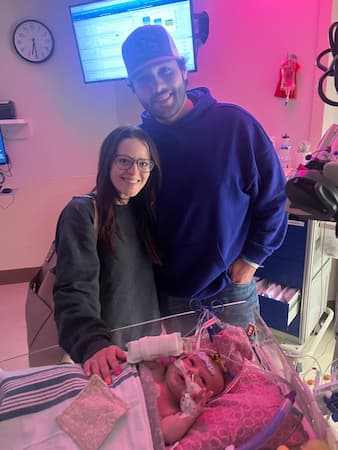Angels work there
After a dramatic highway rescue, Brexley has heart surgery at Children’s Mercy
Meet Brexley

Brexley is a cuddly baby who loves to smile, “talk,” and eat. She’s playful and already developing a feisty attitude, according to her parents, Gracie Gray and Kahl Huffman.
But when Brexley was only 18 days old, she stopped breathing while her family was driving in Kiowa County, Kansas. Gracie and Kahl dialed 911 as they tried to resuscitate their daughter.
Master Trooper Evan Jacks of the Kansas Highway Patrol answered the call and performed infant CPR until Brexley regained consciousness and started crying. Evan knew what to do because his own child had recently required CPR. He applied the same techniques he saw EMTs use on his child to help Brexley. Brexley’s dramatic rescue was covered by the national news media, including People and Good Morning America.
Brexley was taken to an area hospital then transferred to a medical center in Wichita. There, an echocardiogram revealed Brexley had heart issues, and she was transferred again to the Neonatal Intensive Care Unit at Children’s Mercy.
“Without Children’s Mercy, we wouldn’t be where we are,” said Kahl. “They have some of the biggest minds and hearts you’ll ever meet. They are truly amazing.”
Left-side heart differences

Brexley’s official diagnosis is Shone’s Complex: multiple obstructive lesions or narrowings in the left side of the heart.
“What Brexley had was aortic valve stenosis — the valve between the left ventricle and the aorta did not open very well,” explained Ryan Romans, MD, Ward Family Heart Center physician. “She also had a small aortic arch, and an aortic coarctation, or a narrowing of the aorta.”
These two left-side heart complications made it difficult for Brexley’s heart to pump enough oxygenated blood out to her body.
Dr. Romans thinks Brexley didn’t show any symptoms early on because all babies are born with a blood vessel that connects the aorta and the pulmonary artery, called the patent ductus arteriosus (PDA). This opening is a kind of shortcut that allows blood to circulate without going through the lungs. It closes on its own several days after birth. In Brexley’s case, the PDA acted as a kind of work-around for the obstructions in the left side of her heart.
“The cardiac arrest was the point where [the PDA] closed off enough that she wasn’t able to get enough blood out to her body, and her heart was having to do too much work,” said Dr. Romans. Fortunately, her parents, Trooper Evan and emergency teams got Brexley the help she needed fast. At that point, the NICU and Heart Center at Children’s Mercy were ready to do their part.
Gracie and Kahl said that everyone at Children’s Mercy — from the transport team to the NICU and Cardiac Intensive Care Unit staff to the Ronald McDonald volunteers — were compassionate and made a very scary process much easier on them.
Two-step treatment

The first step toward correcting Brexley’s heart differences was a balloon aortic valvuloplasty. Dr. Romans used a catheter to enter the left ventricle and widen Brexley’s aortic valve.
“We were hoping that by doing a less invasive procedure, we could get the heart function to improve to a point where she would better tolerate aortic arch reconstruction,” said Edo Bedzra, MD, MBA, Heart Center congenital cardiac surgeon, and Director of Cardiac Surgical Innovation.
They gave Brexley some time to recover from the valvuloplasty before her heart surgery. By altering his approach and technique, Dr. Bedzra was able to operate without putting Brexley on a heart and lung machine or cooling her body, which cut down on potential side effects and risks.
“Dr. Bedzra promised us that he and his team would do everything in their power to get her back in our arms,” said Kahl.
“His reassurance really helped us through that surgery,” said Gracie. They waited with family and friends through the five-hour operation.
“We came out with a good repair and no obstruction,” said Dr. Bedzra, “and she did quite well afterward.”
Brexley spent a couple weeks in the hospital recovering, gaining weight and lowering her blood pressure. By early June, Brexley was ready to go home.
Adjusting to a new normal

Back home in Kansas, Brexley is growing fast and sleeping well, and so are her parents, though it took them a while to feel like they could once they were out of the hospital. They have stayed in touch with Trooper Evan, who checks in regularly. Kahl, who went to high school with Evan, reported that Evan just welcomed another baby into his family as well.
Gracie and Kahl take Brexley to her cardiologist every two weeks now. As she grows, Brexley’s team will continue to monitor how well her heart is working. Many patients with Shone's Complex need additional surgeries to re-open the aorta and/or replace a leaky aortic valve sometime during their childhoods.
Dr. Romans said he was impressed with how quickly Brexley’s parents adapted to their family’s new medical reality; parents often struggle to make the mental shift after a sudden diagnosis.
“This family was very quick to say: This is what we have to do, we trust you, and we know you’ll do the best thing for her,” said Dr. Romans. “They’re just very lovely people to work with.”
The respect is mutual. “Angels work there,” said Gracie of Children’s Mercy. “They do some pretty amazing things!”
“Have faith because it’s an amazing team [at Children’s Mercy],” Kahl advised other families facing medical emergencies. “They’ll take care of you and get you through it. They know what they’re doing. God works through them — that’s about the best way to say it!”
